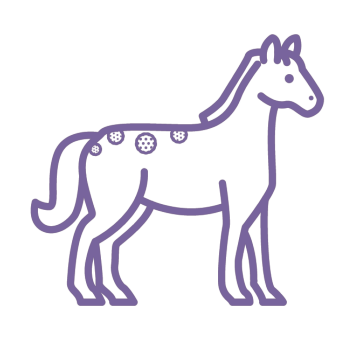HORSES & RINGWORM
One day you saddle up and go for a ride, when all of a sudden you notice something is off about your horse. It’s hard to tell from a distance, so you get a little closer and see that she’s missing patches of hair along her shoulder and neck. The area doesn’t appear infected or inflamed, just flaky. She seems a little irritated when you touch the spot, and there is evidence that she has been trying to scratch the area.
If you’ve ever seen these patches of flaky, dry skin on a horse, you’ve been looking at ringworm. Ringworm is a type of fungus that can form on the upper skin and hair layer of horses and other animals, and can even be contracted by humans. Read on to learn signs and symptoms of ringworm in horses.
What Is Ringworm?
Fungus or ringworm in horses presents itself as hairless patches with crusty, scabby skin. These lesions are most common on the face, neck, shoulders, chest, or under the saddle or girth, but can appear anywhere on the body. The affected areas may become sore and itchy, though sometimes they cause no discomfort at all, which is why it can be hard to notice it until the fungus has developed relatively far into its infectious stages.
The ringworm organism can survive for months on tack, stall walls, or fences, and can be hidden on the skin for up to three weeks before signs become evident. During this time, the fungus can easily spread to other animals, and sudden outbreaks may affect every horse it comes in contact with. Ringworm can be transferred from horse to horse, from horse to tack to horse, etc. Left untreated, the lesions will continue to grow and spread. Ringworm is so pernicious, it may even pass from a horse to a human.
Although the infections might eventually heal on their own, the horse will be highly contagious until then. Instead of waiting out the period of contagious infection, you can treat your horse with products designed to kill the infection quickly.
How Is Ringworm in Horses Treated?
Equiderma's equine ringworm treatment regimen can get rid of infections. Use our products, in conjunction with the steps below, to attack the ringworm infection from every angle:
- Remove hair from infected area: The less hair around the infected area, the better. The fungus grows along the upper layer of skin and hair, so with no hair and an ever decreasing amount of keratin (the infection’s main source of food), it’s more likely that the infection will die off faster and that the treatment you apply will work.
- Shampoo: Wash the horse with Equiderma Sulfate Free Neem Shampoo. Leave the shampoo on for up to an hour for the first treatment if you have the time.
- Apply lotion: Rinse, dry well, and apply Equiderma Skin Lotion. Repeat this treatment every day until the problem has been resolved.
- Keep it clean: Do what you can to keep the lesions clean, dry, and exposed to a healthy amount of air and sunshine. Ringworm is a type of fungus. Most fungi thrive in dark, wet locations. The lighter and airier you keep your horse’s living conditions, the more likely the fungus will die.
Treating a horse effectively-to the point where the ringworm is gone-can take one to two weeks. The amazing thing about using the fungus killing shampoo and lotion is that it temporarily halts the infection’s contagious nature for one to two days. However, the infection will still stick around for at least another week. Keep this in mind as you treat your horse or horses with ringworm.
So pay close attention to your horses. Watch for small patches of flaky skin in the neck, shoulders, face, or parts under the girth or saddle. If you discover you have a horse with ringworm, choose
Equiderma’s ringworm solutions to rid yourself and your horse of the problem.

